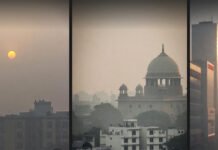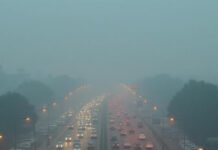INVC NEWS
New Delhi — : Delhi’s battle against air pollution enters a transformative phase with a first-of-its-kind directive mandating the installation of anti-smog guns on all high-rise buildings across the city. In a decisive move aimed at curbing airborne pollutants like PM 2.5 and PM 10, the Delhi government has legally enforced this rule for commercial complexes, malls, hotels, and institutional buildings spanning more than 3,000 square meters in area and rising five floors or more above ground level.
Landmark Environmental Policy Announced by Delhi Government
Delhi Environment Minister Manjinder Singh Sirsa called it a “historic decision,” emphasizing that the capital becomes the first city in India to mandate such a measure for permanent air quality management. “This is for the pure breath of our children. No excuses will be entertained,” Sirsa declared, underlining the non-negotiable nature of the regulation.
The new directive mandates that all applicable high-rise buildings must install and operate anti-smog guns throughout the year, except during the monsoon season from June 15 to October 1. The order strictly excludes residential structures, group housing societies, and standalone homes, making it clear that the focus is on dense, pollution-heavy commercial spaces.
Detailed Installation Requirements and Technical Standards
According to the official guidelines, buildings under the rule must comply with the following technical specifications:
Minimum of 3 anti-smog guns for built-up areas up to 10,000 square meters
One additional gun for every additional 5,000 square meters
Nozzle mist droplet size must range between 5–20 microns, capable of trapping fine particulate matter
Throw range should cover 75–100 meters, ensuring maximum dispersion coverage
Operational timing must follow a strict three-shift routine:
6:30 AM to 9:30 AM
1:30 PM to 4:30 PM
5:30 PM to 8:30 PM
The anti-smog guns must be mounted on permanent brackets on the parapet walls, positioned between the 7th to 10th floor for optimal spraying efficiency. Buildings must also ensure the use of treated water, maintaining a flow of 1,000–1,200 liters per hour, but not exceeding 10,000 liters per 8-hour cycle.
Noise-Control, Smart Integration, and Performance Monitoring
The government’s directive also highlights the use of low-noise blowers and optional real-time air quality sensors. These sensors can monitor the concentration of airborne particles and trigger responsive spraying in real-time. This technology-first approach ensures that air quality is not just monitored but actively managed by each compliant building.
Implementation Timeline and Enforcement Protocol
To enforce the mandate effectively, the Delhi government has given all relevant building owners and management teams six months to complete installation. Non-compliance will attract strict penalties, and enforcement authorities will not tolerate delays or negligence.
The directive designates several civic bodies with the responsibility of oversight and enforcement, including:
Delhi Municipal Corporation
Delhi Development Authority (DDA)
Public Works Department (PWD)
Central Public Works Department (CPWD)
NBCC, DSIIDC, and other relevant agencies
These agencies are required to submit quarterly performance and compliance reports, detailing the number of installations, operational status, and any penalties imposed on defaulters.
Anti-Smog Guns: A Game-Changer for Urban Pollution Control
Delhi’s innovative approach marks a critical step in fighting year-round pollution, especially during winter smog seasons when air quality traditionally plummets. These guns, already used in road construction and demolition sites, will now serve as permanent fixtures on city skylines, signaling a shift from temporary fixes to long-term, institutionalized pollution control.
Key Features of Delhi’s Anti-Smog Directive at a Glance
| Specification | Requirement |
|---|---|
| Applicable Buildings | Commercial, malls, hotels, institutional (>5 floors) |
| Built-Up Area | >3,000 sq. meters |
| Number of Anti-Smog Guns | 3 for up to 10,000 sq. m., +1 for every 5,000 sq. m. |
| Spray Droplet Size | 5–20 microns |
| Throw Range | 75–100 meters |
| Daily Operation Time Slots | 6:30–9:30 AM, 1:30–4:30 PM, 5:30–8:30 PM |
| Mounting Requirements | Permanent brackets, ideally 7th–10th floor |
| Water Use | 1,000–1,200 liters/hour, max 10,000 liters/day |
| Exemptions | Residential buildings and homes |
| Deadline for Compliance | 6 months from notification |
Smog-Free Skies Ahead: Enforcement with Zero Tolerance
Delhi is setting a precedent for urban environmental policy by integrating pollution management at the infrastructure level. With strict monitoring, clear guidelines, and a no-excuse stance from government authorities, the capital is redefining what urban responsibility looks like in the face of climate and health crises. The city’s rooftops are turning into pollution-fighting zones—an aerial defense system for cleaner air and healthier living.
















